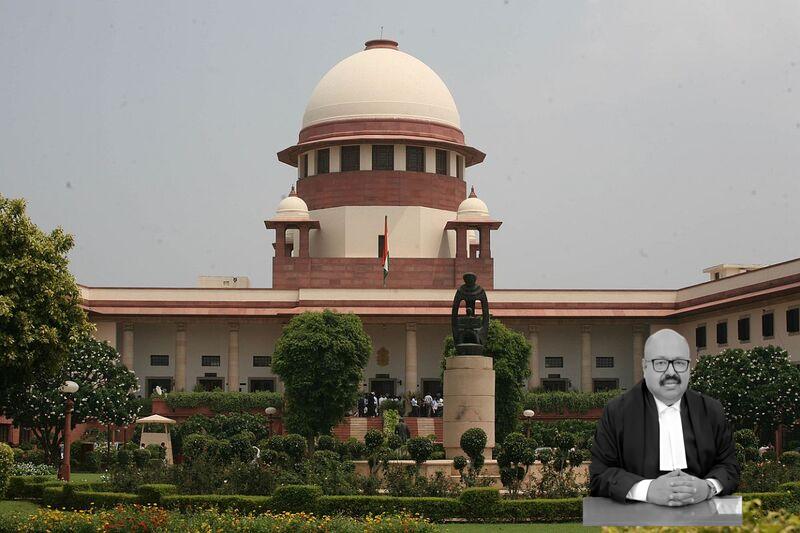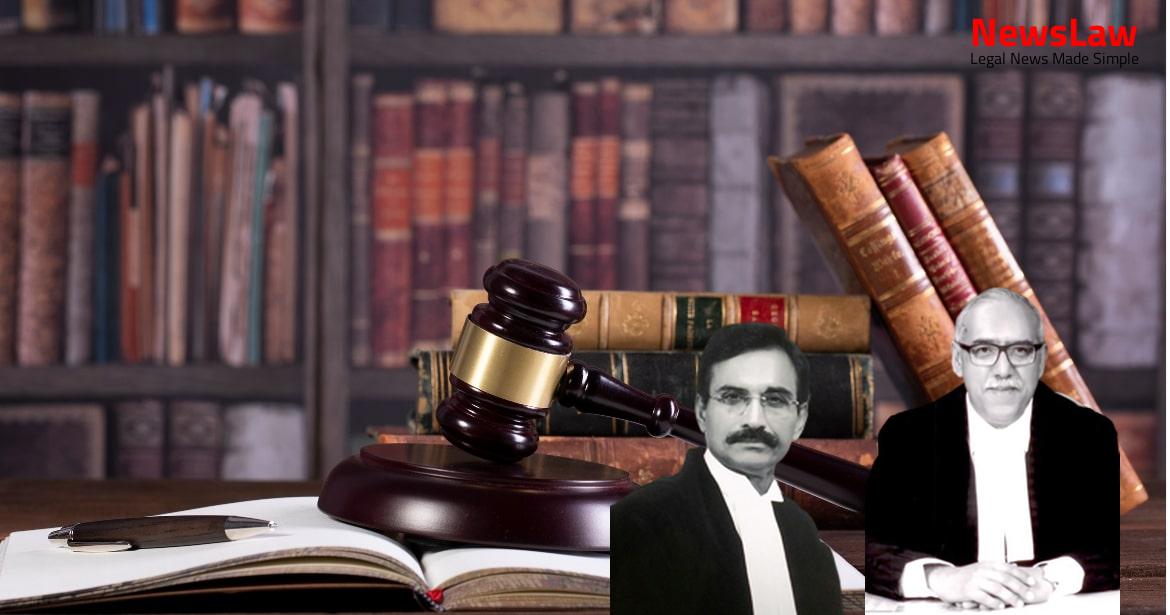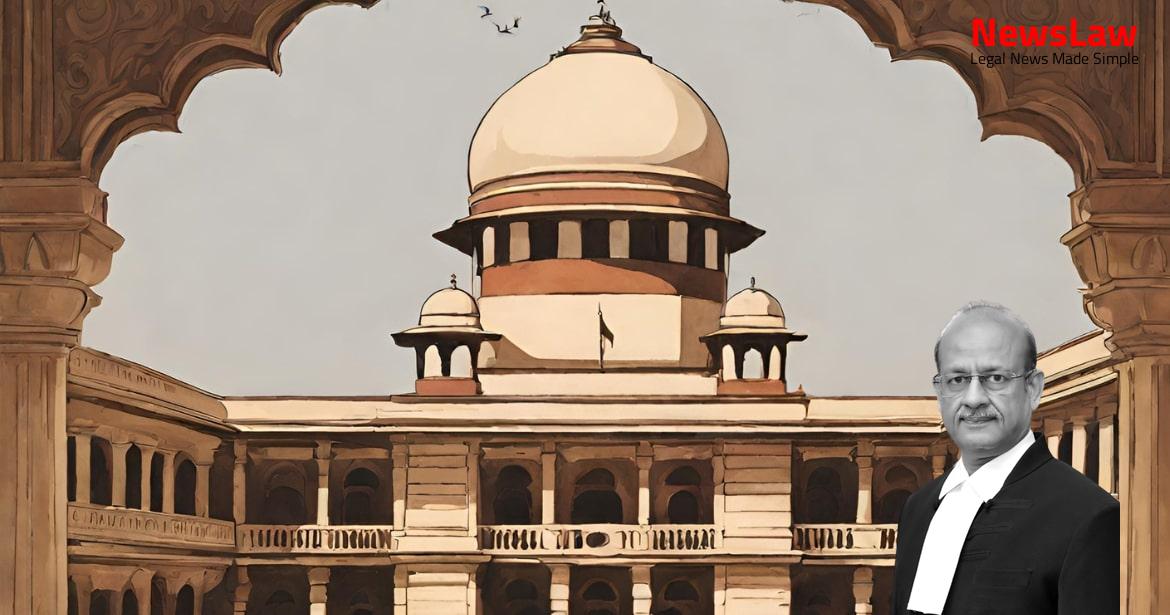This is a defendant’s appeal against the order of the High Court dismissing his second appeal preferred against the judgment and decree of reversal passed by the first appellate Court The first appellate Court had not only set aside the decree of the Trial Court to the extent it denied complete relief as sought in the suit, but decreed the suit of the first respondent in its entirety. The plaint case was that, — (a) the land in dispute admeasuring 3 bighas was jointly purchased by the plaintiff and defendant nos.2 to 4 vide two separate sale-deeds dated 02.03.1970 and 16.03.1970; (b) out of the total area of the disputed land, 1 bigha, comprising a portion of plot no.294/83, was converted to non-agricultural use for setting up a Petrol Pump and, for that purpose, the District Collector issued NOC on 23.07.1971; (c) the Trust had not acquired the land by any lawful manner, yet, it started showing itself as owner in possession of the disputed land, as a result, when, on 23.4.1997, the Trust threatened to acquire the land, the suit had to be instituted. The appellant in its written statement rebutted the plaint case and pleaded that, — the land pertaining to Khasra no.239/83 stood in the name of Bhanwari Devi, which had already been acquired whereas, the land bearing Khasra no.211/81 is out of Jainarain Vikas Colony Scheme; the land in dispute has been duly acquired and compensation paid to the Khatedars ; the suit of the plaintiff is not maintainable; the land in dispute being agricultural, the Civil Court has no jurisdiction; and the plaintiff has not come to the court with clean hands as the disputed land had already been acquired and compensation paid to the recorded Khatedars.
Then it was discovered that the plaintiff along with others had purchased the land in dispute vide sale deeds dated 02.03.1970 and 16.03.1970 and had also given an application for conversion of 1 bigha of that land for non-agricultural use, which was allowed, and, on payment of conversion fee, NOC was issued for setting up a Petrol Pump. The trial court found that there is no dispute between the parties that 1 bigha, out of 3 bighas of the land in dispute, was converted to non-agricultural land and that it was not acquired by the State. Consequently, the decree of the trial court to the extent of 1 bigha of the disputed land became final as against the Trust. Before the first appellate court, on behalf of the plaintiff, it was argued that acquisition proceedings of the land had commenced in the year 1972 whereas the two sale-deeds in favour of the plaintiff were registered in the year 1970. In paragraph 18 of the judgment, the first appellate court observed that admittedly prior to the acquisition, NOC was issued to the plaintiff for conversion of agricultural land to non- agricultural land, therefore it is to be assumed that the State was aware of the ownership right of the plaintiff. The appellant preferred second appeal before the High Court contending, inter alia, (a) mere suit for injunction is not maintainable unless a relief for declaration of title is sought; (b) the civil court has no jurisdiction to decide the suit when the land in dispute is subject matter of acquisition and, under Section 52 of the 1959 Act, on publication of the notification in the gazette, the land stood vested in the State free from all encumbrances; and (c) the plaintiff had failed to implead the State as a defendant even though it was a necessary party. Learned counsel for the appellant contended that Chapter VII of the 1959 Act deals with acquisition and disposal of land by the Trust. Sub-section (5) of Section 52 provides that where any land is vested in the State Government under sub- section (4), the State Government may, by notice in writing, order any person who may be in possession of the land to surrender or deliver possession thereof to the State Government or any person duly authorized by it in this behalf within 30 days of the service of the notice. Thus, the 1959 Act is a complete Code insofar as acquisition of the land, payment of compensation for its acquisition and settlement of disputes regarding the compensation payable therefor are concerned. Regarding non-service of notice upon the owners of the land prior to the notification under Section 52(1) of the 1959 Act, the learned counsel for the appellant submitted that as the original Khatedars, who stood recorded in the record of rights, were served with notice of the proposed acquisition, there was substantial compliance of the provisions of sub-section (2) of Section 52 of the 1959 Act. In support of his submissions, the learned counsel for the respondents placed reliance on a Constitution Bench decision of this Court in Dhula Radhabhai vs. On consideration of the rival submissions, in my view, the following questions arise for determination: (i) Whether for failure to serve notice under sub-section (2) of Section 52 of the 1959 Act on the plaintiff, the notification acquiring the land under sub-section (1) of Section 52 of the 1959 Act could be treated as void by the Civil Court? In the light of settled legal position, the question which falls for consideration is, whether for want of service of notice of proposed acquisition under sub-section (2) of Section 52 of the 1959 Act, the acquisition notification, under section 52 (1) of the 1959 Act, could be treated as void and, therefore, vulnerable to a collateral attack.
Compulsory acquisition of land – (1) Where on a representation from the Trust it appears to the State Government that any land is required for the purpose of improvement or for any other purpose under this Act, the State Government may acquire such land by publishing in the official Gazette a notice specifying the particular purpose for which such land is required and stating that the State Government has decided to acquire the land in pursuance of this section. (5) Where any land is vested in the State Government under sub-section (4), the State Government may, by notice in writing, order any person who may be in possession of the land to surrender or deliver possession thereof to the State Government or any person duly authorized by it in this behalf within thirty days of the service of the notice. Sub section (4) of Section 53 provides that where no such agreement is reached, the State Government shall refer the case to the Collector for determination of the person to whom the amount of compensation is to be paid and the amount of compensation to be paid for such acquisition. Section 54 of the 1959 Act provides that any party aggrieved by the decision of the Collector determining the amount of compensation may, within sixty days from the date of such decision, appeal to the court of the District Judge having jurisdiction. A conspectus of the provisions of Chapter VII of the 1959 Act makes it clear that once the acquisition notification is published in the Official Gazette under sub-section (1) of Section 52 of the 1959 Act, by virtue of sub section (4) of Section 52, the land shall, on and from the date of such publication, vest absolutely in the State Government free from all encumbrances and, thereafter, the owner or person interested in the land is entitled to receive compensation.
According to the learned counsel for the respondents, where the mandatory provisions of sub- section (2) of Section 52 of 1959 Act are not followed, the notification issued thereunder would be a nullity and, therefore, the Civil Court’s jurisdiction to grant appropriate relief shall not be ousted. The State contested the suit by claiming that it was barred by Section 17 of the Madhya Bharat Sales Tax Act. (2) Where there is an express bar of the jurisdiction of the court, an examination of the scheme of the particular Act to find the adequacy or the sufficiency of the remedies provided may be relevant but is not decisive to sustain the jurisdiction of the civil court. (3) Challenge to the provisions of the particular Act as ultra vires cannot be brought before Tribunals constituted under that Act.
On appeal, the High Court of Punjab held that even though the imposition of tax might not be authorized but the civil court had no jurisdiction to entertain the suit as the Act provided for a remedy by way of appeal against the wrong orders of the authorities thereunder. The statute may specifically provide for ousting the jurisdiction of civil courts; even if there was no such specific exclusion, if it creates a liability not existing before and gives a special and particular remedy for the aggrieved party, the remedy provided by it must be followed. The decisions of this Court in Dhulabhai (supra) and Firm Seth Radha Kishan (supra) reiterate the settled legal position that if the act impugned is not under the statute but in violation of its provisions, the jurisdiction of a civil court is not completely ousted even though the statute may have created the liability and provided for a specific remedy to the person aggrieved.
In my view, the aforesaid submission is not acceptable for the following reasons: (a) there is no challenge to the jurisdictional power of the acquiring body to issue notification under Section 52(1) of the 1959 Act, therefore the notification is under the 1959 Act and not beyond the scope of the 1959 Act; (b) it is not the case of the plaintiff that pursuant to the sale-deeds qua the land in dispute, prior to the date of acquisition notification, plaintiff’s name was entered in the record of rights, yet no notice under Section 52(2) was served on him prior to the acquisition; (c) it is also not the case of the plaintiff that landowners/ Khatedars already recorded in the record of rights qua the land in dispute, were not served with notice as contemplated by sub-section (2) of Section 52 of the 1959 Act; and (d) there is a presumption that official acts have been regularly performed (see: Section 114 Illustration (e) of the Indian Evidence Act, 1872), therefore, once a notification under sub- section (1) of Section 52 was issued, by virtue of sub-section (4) of Section 52, in my view, a legal fiction with regard to the vesting of The plaintiff and defendant nos.2 to 4 neither claim that they were recorded in the record of rights prior to that, nor do they claim that none of the recorded owners was served with notice. 2 to 4 were owners of the land, pursuant to sale-deeds of the year 1970, yet they were not served notice, under sub-section (2) of Section 52, prior to the notification under sub-section (1) of Section 52 and, therefore, the notification, under sub- section (1) of Section 52, is illegal and void.
It was also argued that Sections 127, 128 and 129 of the Karnataka Land Revenue Act, 1964 cast an obligation on the Registering Officer to make a report to the revenue authority to enter his name in the record of rights and its failure to do so resulting in non-service of the notice on the appellant, depriving him of the opportunity to file his objections, should not act to his detriment or disadvantage. Amritsar Improvement Trust [(1996) 11 SCC 644] has taken the view that failure to serve personal notices on the persons whose names have not been mutated in the official record-of-rights in pursuance of any sale in their favour does not vitiate the proceedings for acquisition. The Collector in the present case was thus justified in relying on the official record being the record-of-rights as to who were the owners of the land sought to be requisitioned and prudence did not require any further enquiry to be made. This apart, failure to make entries on the part of the Revenue Authorities by itself would not cast any obligation on the authorities under the Act to make a roving enquiry and try to locate an owner who may have subsequently purchased the land from the previous owner. Having noticed the decision in Ahuja Industries (supra), in my view, the legal position that emerges is, that if the name of the owner is not entered in the record of rights pertaining to the land proposed to be acquired, there is no legal obligation on the state authorities to make a roving enquiry to find out as to who its actual owner is for effecting service of notice upon him prior to issuance of the acquisition notification. A careful reading of the same would indicate that the plea of the plaintiff was that he sought conversion of one bigha, out of three bighas of the disputed land, for non-agricultural use and, in connection therewith, a favorable report was given by the Patwari resulting in issuance of an NOC by the District Magistrate for non-agricultural use of one bigha land. I, therefore, reject the argument that by issuing NOC for non-agricultural use of one bigha of the disputed land, the State acquired knowledge regarding plaintiff’s title in respect of the entire land comprising 3 bighas.
Therefore, once it is established that the plaintiff was not recorded as the owner in the record of rights on the date of issuance of the notification for acquisition of the land, taking into account the law laid down in Ahuja Industries (supra), I’m of the view that mere non-service of notice, under Section 52 (2) of the 1959 Act, upon non-recorded owner, such as the plaintiff, would not render the acquisition notification under Section 52(1) void. As I have held that the acquisition notification could not have been disregarded as void, the question that would now arise for consideration is whether the suit of the plaintiff for injunction simpliciter, without seeking a declaratory relief, would be maintainable in a Civil Court. Buchi Reddy, this Court had the occasion to lay down general principles as to when a mere suit for permanent injunction will lie, and when it is necessary to file a suit for declaration and/or possession with injunction as a consequential relief. Where the plaintiff is in possession, but his title to the property is in dispute, or under a cloud, or where the defendant asserts title thereto and there is also a threat of dispossession from the defendant, the plaintiff will have to sue for declaration of title and the consequential relief of injunction. On the other hand, where the plaintiff has clear title supported by documents, if a trespasser without any claim to title or an interloper without any apparent title, merely denies the plaintiff’s title, it does not amount to raising a cloud over the title of the plaintiff and it will not be necessary for the plaintiff to sue for declaration and a suit for injunction may be sufficient.
Where the plaintiff, believing that the defendant is only a trespasser or a wrongful claimant without title, files a mere suit for injunction, and in such a suit, the defendant discloses in his defence the details of the right or title claimed by him, which raise a serious dispute or cloud over the plaintiff’s title, then there is a need for the plaintiff, to amend the plaint and convert the suit into one for declaration. In addition to what has been discussed above, there are multiple decisions to the effect that the validity of an acquisition notification, acquiring land under compulsory land acquisition laws for public purpose, cannot ordinarily be questioned in a Civil Court, though its validity may be questioned before a superior court by invoking its powers under the Constitution of India. The question that arose for consideration by this Court was whether a civil suit would be maintainable and whether ad-interim injunction could be issued where proceedings under the 1894 Act were taken pursuant to a notice issued under Section 9 of the 1894 Act. Section 11A now prescribes limitation to make the award within 2 years from the last of date of publication envisaged under s.6 of the Act. Gram Panchayat, Kararia, validity of the acquisition and of the award was challenged by instituting a civil suit for a declaration that the land could not be acquired. The contention raised on behalf of the petitioner before this Court was that once the acquisition proceedings were dropped by the Land Acquisition Officer, he had no jurisdiction or power to reopen the same and to make the award under Section 11 of the 1894 Act. It is seen that Section 9 of the Civil Procedure Code, 1908 gives jurisdiction to the civil court to try all civil suits, unless barred. If the Government intends to withdraw from the acquisition before taking possession of the land, procedure contemplated under Section 48 requires to be adhered to. By necessary implication, the power of the civil court to take cognizance of the case under Section 9 CPC stands excluded and a civil court has no jurisdiction to go into the question of the validity or legality of the notification under Section 4, declaration under Section 6 and subsequent proceedings except by the High Court in a proceeding under Article 226 of the Constitution. Reverting to the present case, the acquisition is for a public purpose, namely, development of land for residential colony and, by virtue of sub-section (4) of Section 52 of the 1959 Act, the land stood vested in the State free from all encumbrances with effect from the date of publication of the notification. The State was a necessary party because all the steps taken for acquisition of land under sub-section (1) of Section 52 of the 1959 Act were taken by it.
The learned Munsif must remember that if on a meaningful -not formal- reading of plaint it is manifestly vexatious, and meritless, in the sense of not disclosing a right to sue, he should exercise his power under Order 7, Rule 11 CPC taking care to see that the ground mentioned therein is fulfilled.
The High Court has entered these findings despite the fact that by a process of engineered drafting, the first respondent sought no reliefs in regard to the proceedings under the ULCRA (to obviate bar to the maintainability of the suit) and did not implead either the State or the Competent authority who would have been in a position to answer the challenge.” (Emphasis supplied) 64. Thus, in my considered view, in respect of the land covered by the acquisition notification, the Suit as framed was not maintainable, not only for not seeking a declaratory relief but also for not impleading the State as a party. To appropriately address the issue as to whether the suit in the Civil Court was barred by Section 207 (2) of the 1955 Act, it would be useful to examine the scheme of the 1955 Act as also whether the reliefs claimed in the suit were within the scope of the reliefs which could be sought for under the 1955 Act. In so far as that one bigha of land, which was converted to non- agricultural use, is concerned, no dispute survives as the appellant gave up its claim to it and the trial court passed a decree in respect thereof, which has attained finality.
Case Title: URBAN IMPROVEMENT TRUST, BIKANER Vs. GORDHAN DASS (D) THROUGH LRs. & OTHERS …
Case Number: CIVIL APPEAL NO.8411 OF 2014 (2023 INSC 935 )



